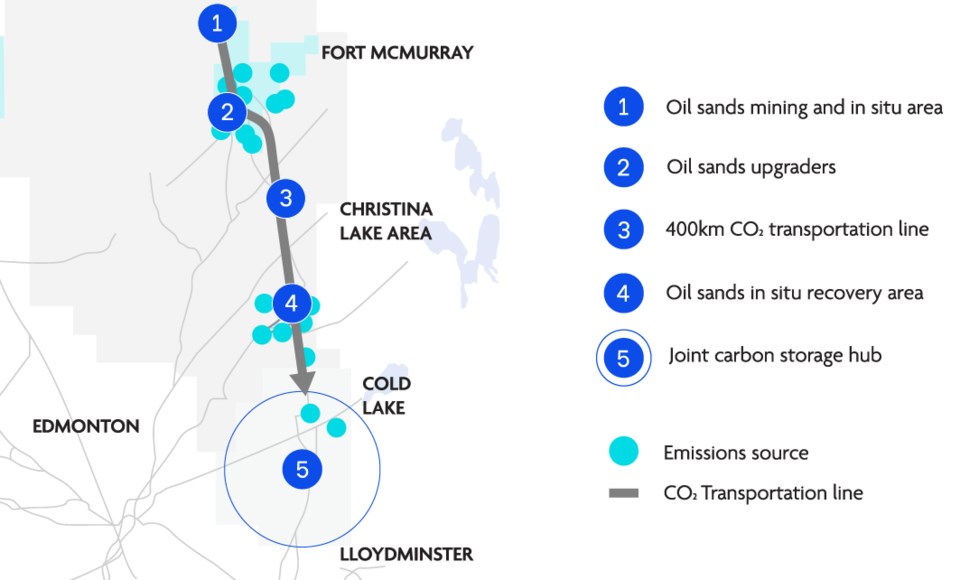Ecojustice, an environmental law charity group, has requested the Alberta government and the Alberta Energy Regulator (AER) order an environmental impact assessment (EIA) for Pathways Alliance’s carbon capture storage (CCS) project as a whole, rather than in pieces.
The request was made on May 14, on behalf of environmental organizations Alberta Wilderness Association, the locally based “No to CO2 Landowner’s Group,” Environmental Defence, Climate Action Network, as well as the Athabasca Chipewyan First Nation (ACFN).
Water use and pollution concerning
The group is worried about the environmental impacts and health and safety concerns associated with CCS technology.
According to the group, CCS generates heat and must cool itself with water. This water consumption puts further stress and pressure on the watershed withdraws from.
CCS also contributes to regional air and water pollution, according to the group, due to CCS technology burning natural gas. There is also the risk of explosion and leakage.
The group also argues that CCS is an unproven technology.
County of St. Paul resident and “No to CO2” member Amil Shapka, questions if the Lakeland community - where a large portion of the CCS hub will be located - is ready for potential health, safety, and environmental risks of the technology.
The group says an EIA is also required for Alberta to fulfill its constitutional obligation to consult with local Indigenous communities. In a May 14 press release, ACFN Chief Allan Adam, said that without an EIA, “Not only does this undermine our Treaty rights but it also puts the project at serious legal risk.”
According to information from Pathways Alliance, a group that is made up of several oil and gas companies, the organization has hosted a series of open houses in the Cold Lake region for Indigenous groups and various stakeholders, as well as hosted tours on an operating CCS facility.
Kendall Dilling, president of Pathways Alliance, said in an emailed statement to Lakeland This Week that, “We are proactively consulting and engaging on the CCS project as a whole with all interested parties to understand their concerns, including providing materials and resources related to the full project.”
Environmental field studies are also ongoing, according to Dilling, stating they are supporting communities with completing traditional land use studies.
“The environmental field program has been surveying the proposed transportation line and storage hub project areas conducting hundreds of heritage resource assessments, wetland classifications, soil assessments and aquatic habitat evaluations,” he said.
In a previous Lakeland This Week story, Dilling said Pathways also recognizes concerns to CCS, and is working to alleviate those concerns. They created a fact sheet in response to concerns they heard from various stakeholders.
Why does Ecojustice want an Environmenta Impct Assesment?
Ecojustice, in their letter of request, highlights and argues the necessity for the AER to specifically order an EIA for the Pathways’ project as a whole, rather than doing an EIA for Pathways’ numerous individual applications separately.
Under the current oil and gas regulatory framework, AER said they treat each component of a CCS project - like pipelines, facilities, and wells - as separate applications.
“Normally, if an environmental impact assessment report is required it would be filed and considered together with filed applications,” said Coral Hulse, AER spokesperson. This means if an EIA report is required for one of Pathways’ applications for example, a decision on their other applications would not be made until the EIA report is completed.
Each application is posted online, giving people or groups a chance to voice their concerns if they think they might be directly affected, called a Statement of Concern (SOC).
The AER then reviews these concerns to decide if a public hearing is necessary. “The AER has broad discretion to decide to send applications to a hearing and can consider any factor that it deems appropriate when making that decision,” said Hulse.
Ecojustice says capture project as a whole needs to be looked at
Matt Hulse, Ecojustice lawyer, argued that an EIA is essential to the project as a whole than in segments – called project splitting – because it would consider all impacts of the project together.
Assessing the whole project by segments only considers the direct impacts of each segment to the surrounding landscape and people nearby, said Matt.
“While this is important, there is no assessment of the cumulative impacts of all those segments together, which is important with such a large project: 13 facilities, more than [600 kilometre] of pipeline, and a very large underground storage area,” said Matt.
He also believes that a segmented assessment overlooks the indirect effects of the project as a whole, such as how it does not consider how the project might encourage further oil sands expansion or the risk of the project becoming a "stranded asset" if the carbon capture infrastructure becomes obsolete in the future.
Segmented assessment also limits public participation, he said, because people can only comment on segments that directly affect them, leaving out those who might be indirectly affected by the project.




